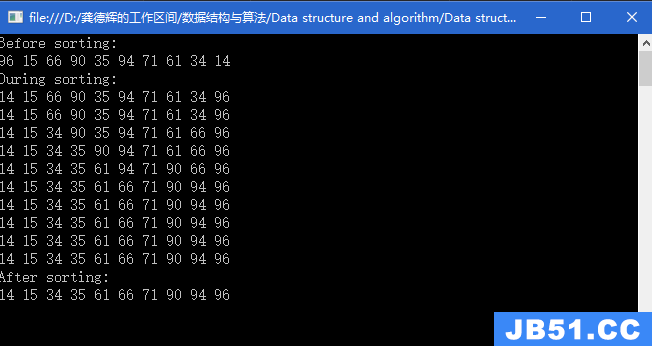#include "stdio.h" #include "stdlib.h" #include "io.h" #include "math.h" #include "time.h" #define OK 1 #define ERROR 0 #define TRUE 1 #define FALSE 0 #define MAXEDGE 20 #define MAXVEX 20 #define INFINITY 65535 typedef int Status; /* Status是函数的类型,其值是函数结果状态代码,如OK等 */ typedef struct { int vexs[MAXVEX]; int arc[MAXVEX][MAXVEX]; int numVertexes,numEdges; }MGraph; typedef int Patharc[MAXVEX][MAXVEX]; typedef int ShortPathTable[MAXVEX][MAXVEX]; /* 构件图 */ void CreateMGraph(MGraph *G) { int i,j; /* printf("请输入边数和顶点数:"); */ G->numEdges=16; G->numVertexes=9; for (i = 0; i < G->numVertexes; i++)/* 初始化图 */ { G->vexs[i]=i; } for (i = 0; i < G->numVertexes; i++)/* 初始化图 */ { for ( j = 0; j < G->numVertexes; j++) { if (i==j) G->arc[i][j]=0; else G->arc[i][j] = G->arc[j][i] = INFINITY; } } G->arc[0][1]=1; G->arc[0][2]=5; G->arc[1][2]=3; G->arc[1][3]=7; G->arc[1][4]=5; G->arc[2][4]=1; G->arc[2][5]=7; G->arc[3][4]=2; G->arc[3][6]=3; G->arc[4][5]=3; G->arc[4][6]=6; G->arc[4][7]=9; G->arc[5][7]=5; G->arc[6][7]=2; G->arc[6][8]=7; G->arc[7][8]=4; for(i = 0; i < G->numVertexes; i++) { for(j = i; j < G->numVertexes; j++) { G->arc[j][i] =G->arc[i][j]; } } } /* Floyd算法,求网图G中各顶点v到其余顶点w的最短路径P[v][w]及带权长度D[v][w]。 */ void ShortestPath_Floyd(MGraph G,Patharc *P,ShortPathTable *D) { int v,w,k; for(v=0; v<G.numVertexes; ++v) /* 初始化D与P */ { for(w=0; w<G.numVertexes; ++w) { (*D)[v][w]=G.arc[v][w]; /* D[v][w]值即为对应点间的权值 */ (*P)[v][w]=w; /* 初始化P */ } } for(k=0; k<G.numVertexes; ++k) { for(v=0; v<G.numVertexes; ++v) { for(w=0; w<G.numVertexes; ++w) { if ((*D)[v][w]>(*D)[v][k]+(*D)[k][w]) {/* 如果经过下标为k顶点路径比原两点间路径更短 */ (*D)[v][w]=(*D)[v][k]+(*D)[k][w];/* 将当前两点间权值设为更小的一个 */ (*P)[v][w]=(*P)[v][k];/* 路径设置为经过下标为k的顶点 */ } } } } } int main(void) { int v,k; MGraph G; Patharc P; ShortPathTable D; /* 求某点到其余各点的最短路径 */ CreateMGraph(&G); ShortestPath_Floyd(G,&P,&D); printf("各顶点间最短路径如下:\n"); for(v=0; v<G.numVertexes; ++v) { for(w=v+1; w<G.numVertexes; w++) { printf("v%d-v%d weight: %d ",v,D[v][w]); k=P[v][w]; /* 获得第一个路径顶点下标 */ printf(" path: %d",v); /* 打印源点 */ while(k!=w) /* 如果路径顶点下标不是终点 */ { printf(" -> %d",k); /* 打印路径顶点 */ k=P[k][w]; /* 获得下一个路径顶点下标 */ } printf(" -> %d\n",w); /* 打印终点 */ } printf("\n"); } printf("最短路径D\n"); for(v=0; v<G.numVertexes; ++v) { for(w=0; w<G.numVertexes; ++w) { printf("%d\t",D[v][w]); } printf("\n"); } printf("最短路径P\n"); for(v=0; v<G.numVertexes; ++v) { for(w=0; w<G.numVertexes; ++w) { printf("%d ",P[v][w]); } printf("\n"); } return 0; }


